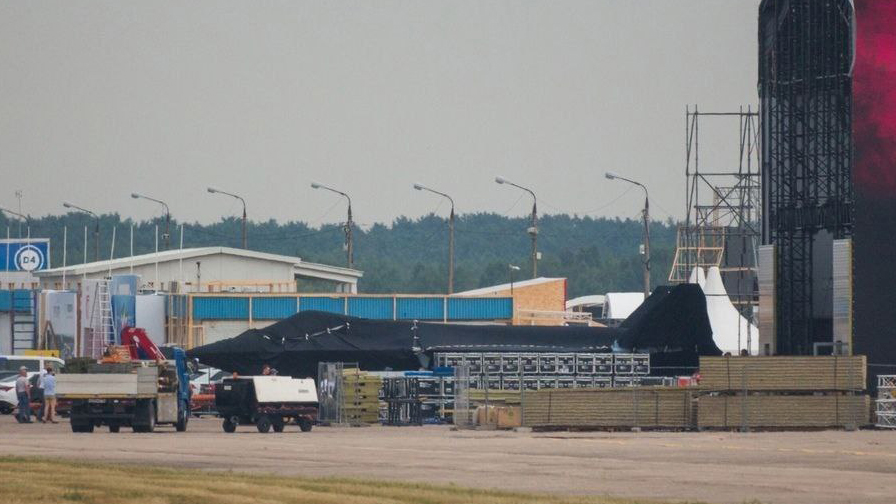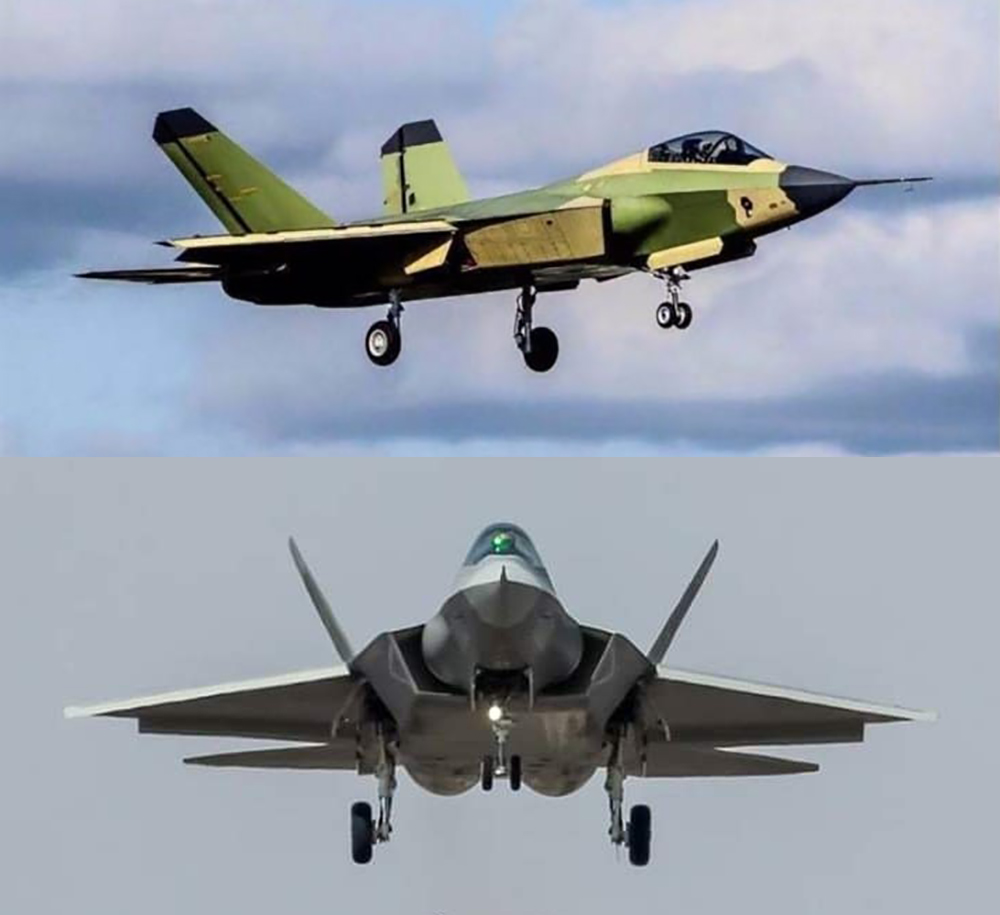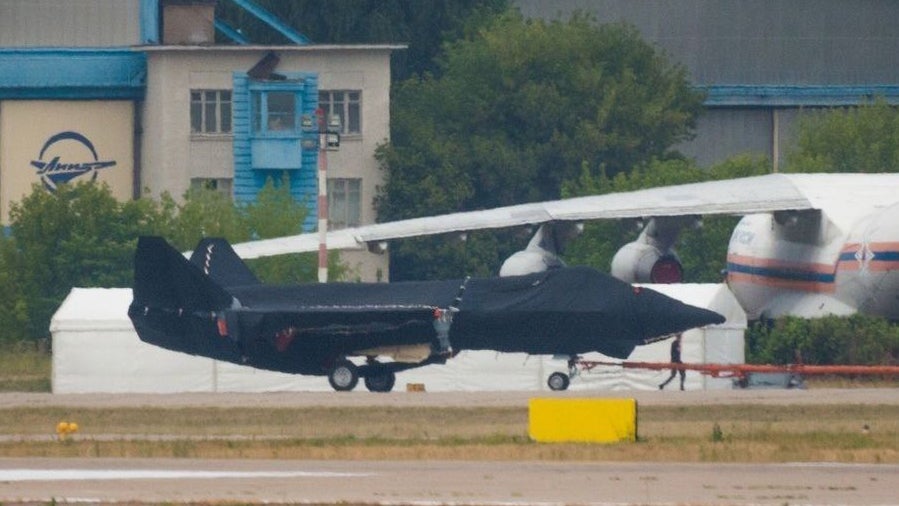Russia’s new fighter, which appears, at least at this time, to be named Checkmate, is a single-engine light-to-medium weight design, based on more photos of the jet that have emerged since it made its surprise, unofficial appearance at Zhukovsky International Airport, outside Moscow, yesterday. While it’s vital to remember that we don’t know — yet —whether this is a full-size mock-up or a real aircraft, its engine configuration is a significant piece of the puzzle. The aircraft is set to be officially revealed next week at the MAKS international air show at Zhukovsky, but until then, here is our preliminary analysis.
The fighter, which appeared at Zhukovsky wrapped in a black covering, has now been photographed from additional angles, albeit with most details still obscured. However, a view from the rear shows a telltale outline of a single round engine exhaust nozzle. Although it’s not clear what type of engine is installed, mock-up or otherwise, this confirms many rumors that the fighter would indeed be a single-engine type.

Meanwhile, the designer appears to be Sukhoi, with the company’s logo (in Cyrillic) appearing on the side of the large hangar in the background of the photos, which has been draped in Checkmate marketing banners for the unveiling.
Last May 26, Russia’s TASS state-run news agency reported that Sukhoi was “developing the first Russian single-engine light tactical fighter with supersonic speed and low radar signature.” According to the same article, the aircraft would have a takeoff weight of up to 18 tons, fly at Mach 2-plus, and feature thrust-vectoring engine controls. While we can’t be sure that the aircraft seen at Zhukovsky is the same Sukhoi design, it does appear to broadly fit the description.
Intriguingly, there has not been a new single-engine Russian fighter built since the Cold War and the country has, since then, been lukewarm about procuring any new aircraft in this class.
That reality would tie in with the idea that the new fighter is being aimed squarely at the export market, perhaps as a low-observable, high-technology successor to the MiG-35, the latest expression of the Cold War-era MiG-29 family. The impression that’s given by the PR campaign so far, which has included an English-language teaser on Twitter and a video that features “air force pilots” from the United Arab Emirates, India, Vietnam, and Argentina, certainly points to this being primarily an export offering.

One or more of those countries may be more receptive to buying a single-engine jet than the Russian military, especially if the offering is a low-observable fighter that provides some of the technologies developed for its existing twin-engine, heavyweight Su-57, but with a proportionally lower price tag and sustainment cost. So far, efforts to sell the Su-57 to foreign air arms have failed including, most spectacularly, in India.
On the other hand, it’s worth noting that the successful Su-30 multirole fighter family relied almost entirely on Indian funding to make any progress through much of the 1990s and 2000s and this aircraft had already won a number of export orders before Russia, too, bought into it and acquired the Su-30SM version.
Apart from the F-35, which was tailored to a unique tri-service requirement, including a short takeoff and vertical landing (STOVL) version, all other so-called fifth-generation fighter designs to have made any significant progress to date have adopted a twin-engine layout. In selecting a single-engine arrangement, the United Aircraft Corporation will hope to drive down overall costs and complexity and potentially challenge single-engine rivals on the export market, such as the Sino-Pakistani JF-17 Thunder.
From that perspective, the single-engine decision may make sense but it’s unclear what engine has been chosen for the aircraft, although it appears to have a round nozzle. The new-generation Izdeliye 30 engine would be the obvious candidate, offering more power and increased reliability compared to the AL-41F1 turbofan now used in the Su-57. However, the Izdeliye 30, which is expected to produce around 16-17 tons of thrust, is currently still in development. In the meantime, it’s likely the AL-41F1, producing around 14.5 tons of thrust, would be used in the new fighter, even if only temporarily. Both the Izdeliye 30 and AL-41F1 feature thrust-vectoring for improved maneuverability.
In the past, there has even been talk of a potential new STOVL fighter design from Russia, which would also presumably involve a single-engine configuration with a lift-fan, as found in the F-35B. However, domestic demand for STOVL fighters is currently strictly limited, especially bearing in mind the status of the Russian Navy’s single aircraft carrier, although the two planned amphibious assault ships may have the potential to be completed for fixed-wing aviation operations. Beyond that, it’s questionable if there would be much foreign interest in that type of aircraft.
Aside from its one engine, what else can we gauge about the new Russian fighter at this point?
The engine intake, in particular, is a puzzle. From some angles, the covered-up aircraft seems to be fitted with side-mounted intakes similar to those on the F-22, or the diverterless supersonic inlet (DSI) type found on the F-35. In at least one profile view, as Aviation Week’s Defense Editor Steve Trimble has pointed out, the aircraft even seems to have a pentagon-shaped intake that begins just below the forward part of the cockpit canopy.
This DSI arrangement would parallel a desktop model of an as-yet-unknown fighter design that appeared on the desk of Russian Deputy Prime Minister Yuri Borisov late last year.
The fuselage seems to adopt the blended wing/body configuration found across most new-generation fighter types, with a prominent chine running along the centerline and perhaps incorporating prominent leading-edge vortex controllers, or LEVCONS, as found on the Su-57. These moving surfaces serve to increase lift and maneuverability at low speeds and, on the Su-57, reportedly also boost maneuverability at supersonic speeds.
The outward-canted tailfins are prominent, but there’s no sign, as yet, of horizontal tail surfaces, or canard foreplanes. In the general configuration, the aircraft may have similarities in some of the Joint Advanced Strike Technology (JAST) designs that preceded the Joint Strike Fighter program, as well as developmental initiatives like Subsonic High Alpha Research Concept (SHARC), which was evaluated by NASA in the 1990s.

The landing gear on the new fighter appears very realistic, providing this is indeed a mock-up, with obvious shock-absorbing oleo struts. It also looks notably robust, but not too much can be read into this. For some generations now, Russian land-based fighters have been provided with heavy-duty landing gear to allow operations from poorly prepared surfaces. The complexity of the gear point to this article being either a highly elaborate mock-up or something further along, developmentally speaking.
While the cockpit canopy is clearly visible, there is the possibility that, at some point, the new fighter could be fielded in an unmanned or optionally manned configuration, too. According to the TASS article from last May, the jet being developed by Sukhoi “can be a universal platform in manned and unmanned versions.” Such a program could perhaps leverage technology developed for the S-70 Okhotnik unmanned combat air vehicle, which Sukhoi is developing under the so-called Strike-Reconnaissance Unmanned Complex program. As such, it is possible that unmanned or optionally manned variants of this design could work alongside manned aircraft in a loyal wingman role, or as independent UCAVs. While this may be an exciting-sounding concept, it is harder to execute than it sounds and would likely be part of a spiral development roadmap, if it is envisioned for this type at all.

The ability to offer a somewhat economical fighter with some low observable features and advanced sensors and avionics on the international market would be a significant coup, but there is little evidence Russia is in a position to do that independently without sacrificing other major defense initiatives. In order to do so, Russia is likely looking for a foreign partner to team up with that will offset at least a sizeable portion of the development costs. Once again, by leveraging as many of the lessons learned and even subsystems and components from the Su-57 program, risk could be reduced and the cost of such a program could become a little less daunting, but significant resources would still have to be applied to the program over multiple years.
However, it’s significant that Russia thinks it can make a mark in the light-to-medium-weight fighter category, which has previously been dominated either by lower-cost designs like the JF-17 or by upgraded Cold War-era jets, like the F-16. While there may well be a market for a cheaper alternative to the F-35, realistically, Moscow will not be going after many potential Joint Strike Fighter customers. More likely customers, such as Algeria, Egypt, and Vietnam, are also not necessarily in the market for single-engined fighters, although inserting some of the same high-end technologies developed for the Su-57 into this smaller and chapter airframe may change that.
That said, any potential customer may have to first address the issue of the Countering America’s Adversaries Through Sanctions Act, or CAASTA, which puts sanctions on countries buying from Russia (and other U.S. adversaries), unless a specific waiver is granted. India, for example, was forced to obtain a waiver to buy Russian-made S-400 air defense systems, and this can be a difficult process.
If a customer is unable to buy the F-35 for political or budgetary reasons and can get around the CAASTA hurdles, the Russian fighter would still face competition from other indigenous advanced light-medium fighter types, providing they continue into production. These include offerings from China, South Korea, and Turkey, to name just three.

Still, the fact that these other aircraft are deep in development could become a major issue when it comes to Russia retaining its current fighter market share. As such, at least in this regard, attempting to develop something similar makes some sense. In addition, it’s no longer just about selling fighters and munitions as well as support for those systems. Advances in unmanned technologies will see loyal wingman drones and unmanned combat air vehicles increasingly integrated with manned types. As such, “owning the infrastructure,” via the base fighter platform will be key to capturing these other tactical combat aircraft sales opportunities. In other words, more is on the line here potentially than what meets the eye today.
With all that being said, we await the official unveiling of the new fighter at Zhukovsky next week with growing interest.
UPDATE:
We have a couple more photos that point to a lower fuselage inlet design.
Say what you will, but the marketing campaign around this aircraft unveil has been pretty incredible.
Hat-tip to Vlad Vinogradoff for kindly sharing his photos with us.
Contact the authors: thomas@thedrive.com and tyler@thedrive.com
